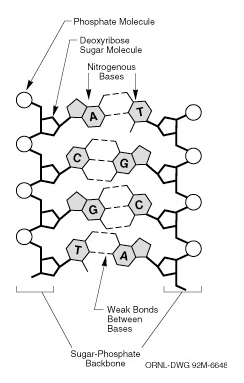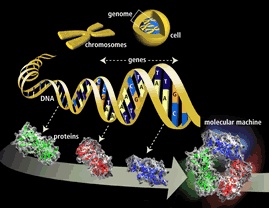Maize genetics
Maize has 10 unique chromosomes - one set of 10 from each parent, for a total of 20 chromosomes. Humans have 26 unique chromosomes, for a total of 46. As in all biological organisms, these chromosomes are strands of DNA that contain the genes that make the proteins that make up the organism. These chromosomes are passed down from generation to generation.

DNA is a two-stranded string-like molecule composed of a backbone of pentose sugars and phosphate groups, with nucleotide bases attached. There are four possible nucleotides: adenine, thymine, guanine and cytosine (usually known simply as A, T, G, and C). The specific order of these nucleotides (known as the “DNA sequence”) is unique to each biological organism, and is often referred to as the “blueprint” of life as it contains all the instructions necessary to form and maintain the organism. Most organisms are composed of sequences that are billions of bases long (table), which are divided up into chromosomes (picture). The shapes of the nucleotides are complementary; A and T bind only to each other, and G and C bind only to each other. Thus, we only need to know the sequence of one of the strands of DNA; we can always deduce the sequence of the other strand (e.g. if we know that one strand has a sequence of ACCGT, then we deduce that the complementary strand has an opposing sequence of TGGCA). This complementarity also makes it possible for DNA to replicate itself (see DNA synthesis and PCR).

Some segments of the nucleotide sequence are made up of genes; other parts have functions such as maintaining the structure of the chromosomes, regulation of gene expression, etc. Maize has approximately 32,000 genes scattered among 2.5 billion bases (by comparison, the human genome contains about 26,000 genes and 2.9 billion bases). Maize has recently been sequenced (i.e. the specific order of the nucleotide bases of its genome has been identified), which means we now know the order of the entire 2.5 billion bases. A popular misconception is that the complexity of an organism is related to the size of its genome: in reality, the number of genes and size of the genome of an organism is not related to its complexity. For example, maize and rice are very similar plants, and yet the genome size of maize is much larger. The difference is because maize has a lot of repeated sequences in its genome that do not code for genes; scientists are not yet sure why this is!


